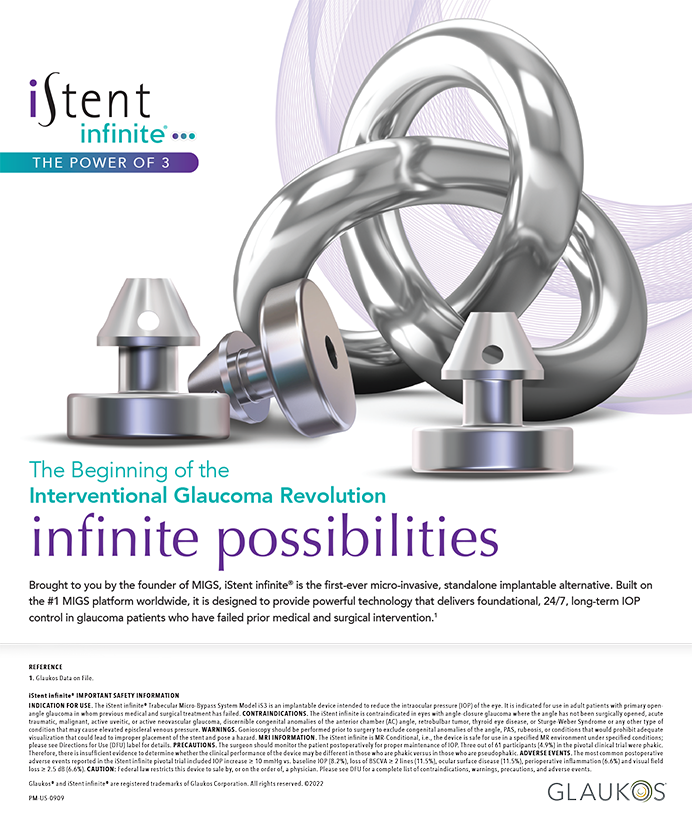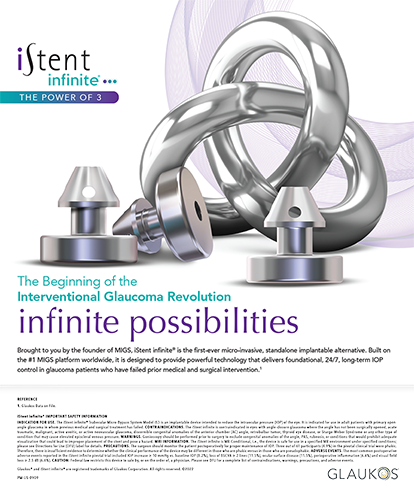CASE PRESENTATION
A 56-year-old white female initially presented for refractive consultation in August 2000. Her refractive error was +2.25 -0.50 X 75 OD = 20/20 BCVA, and +2.75 -0.75 X 150 OS = 20/20-1 BCVA. Her pupils were 4 mm in mesopic light conditions; central keratometry was 42.7 D/42.2 D axis 170 OD and 42.5 D/41.6 D axis 180 OS. The patient had a desire to improve her unaided distance and midrange vision. We discussed her refractive surgery options, and secondary to her concern of night-vision glare and halos, the patient elected to undergo hyperopic LASIK instead of receiving multifocal IOL implants. She tolerated a trial of monovision contact lenses for several weeks prior to undergoing surgery.
The patient's postoperative course was complicated by superficial punctate keratopathy (SPK) and a variable, fluctuating refractive error. She developed regression in both eyes that I observed for 3 months prior to enhancing the right eye (+1.25 -1.25 X 80), and 8 months prior to enhancing the left eye (+1.00 -0.75 X 100). At 18 months after her initial procedure, she presented with recurrent regression in both eyes (+1.00 -0.25 X 90 = 20/20, Ks 44.6/42.7 axis 167 OD and +1.25 -0.50 X 160 = 20/20, Ks 46.3/44.2 axis 20 OS). Figures 1 and 2 provide a more detailed summary of the patient's postoperative course.
HOW WOULD YOU PROCEED?1. Would you elect to perform a second hyperopic LASIK procedure?
2. What is the significance of punctate keratopathy with regard to refractive error?
3. Was this a good LASIK candidate from the start?
SURGICAL COURSE
Unfortunately, SPK following LASIK is a major factor in the variability of refractive error. This is especially true after hyperopic LASIK in which visual clarity is dependent on adequate tear film protecting the centrally steepened cornea. Postoperatively, I treated this patient with preservative-free artificial tears eight to 10 times per day, and placed silicone punctal plugs inferiorly in both eyes.
When I achieved refractive stability in the right eye, I performed an enhancement. It was complicated by peripheral lamellar keratitis, which resulted in epithelial ingrowth. I cleaned out the interface at 6 weeks postenhancement and placed collagen plugs in the upper punctum. Two weeks after cleaning out the right eye and 6 months after I performed LASIK on the left eye, persistent pinpoint staining was present along the border of the right flap margin, in addition to central punctate staining on the left eye. The patient's refraction OS was +2.25 -0.75 X 100, yielding 20/20- vision (remember, the target was -1.25). I placed a permanent punctal plug in the left upper punctum. After 2 weeks, she complained of excessive tearing OS that she deemed socially unacceptable and demanded that the upper plug be removed. I attempted a trial of flaxseed oil, 2,000 mg per day, and preservative-free artificial tears for this patient, which was unsuccessful after 1 month.
The patient developed recurrent ingrowth on the right side, and SPK persisted. I convinced her of the necessity for upper-lid punctal occlusion, despite the increased tearing, in order to promote healing. One month after replacement of the upper punctal plugs, the left-eye SPK resolved, and the refractive error stabilized. I cleaned out the right eye at the same time as I enhanced the left eye in order to restore her -1.25 refractive error. During this session, the patient developed a flap dislocation in the left eye that required repositioning on postoperative day 1.
Two months after an enhancement OS, the patient was again plano -0.50 X 180 20/20 OD, and -1.25 -0.50 X 175 20/20- OS. She requested that the upper plugs be removed because of excess tearing, and I maintained her on the regimen of flaxseed oil, BION Tears (Alcon Laboratories, Fort Worth, TX), Celluvisc (Allergan, Inc., Irvine, CA), and Genteal Gel (Bausch & Lomb). After 4 months, the patient presented again with central punctate staining OS, resulting in decreased vision and regression in both eyes: +1.00 -0.25 X 90 20/20 OD and +1.25 -0.50 X 160 20/20 OS.
OUTCOME
After a consultation regarding the nature of the patient's recurrent symptoms, I convinced her to have silicone punctal plugs placed in the upper punctum of both eyes for yet a third time. At her most recent examination, although again complaining of tearing, she was free of central corneal staining with punctal plugs in all four puncta and using artificial tears twice daily. Her UCVA was 20/25 OD and 20/40 OS; refractive error was +0.50 D OD and -1.25 D OS.
Through my 6 years' experience performing refractive surgery, I have found that women in the perimenopausal age group have a significantly increased risk of dry eye syndrome after LASIK when compared to other subgroups of patients. LASIK-induced neurotrophic epitheliopathy (LNE) caused by the transection of the sub-basal nerve fiber bundle and photoablation of the superficial stromal nerves sets the stage for postoperative dry eyes. The combination of LNE and hormonal changes affecting meibomian secretions leads to a chronic tear film dysfunction that is more prevalent in peri- and postmenopausal women. For this reason, I am leery of performing LASIK on these patients.
Today, my options for this subgroup of patients include presbyopic lens extraction with multifocal lens implantation, sutureless synthetic keratophakia (an investigational procedure), or observation until accommodative IOLs become more readily available. I steer clear of laser refractive surgery procedures, including LASEK and PRK, in this group of patients secondary to the increased difficulty of maintaining an adequate tear film over the centrally steepened cornea.
Mitchell C. Shultz, MD, is in private practice in Northridge, California, and is Assistant Clinical Professor at the Jules Stein Eye Institute, University of California, Los Angeles. He does not hold a financial interest in any of the products mentioned in this article. Dr. Shultz may be reached at (818) 349-8300; izapeyes@aol.com

